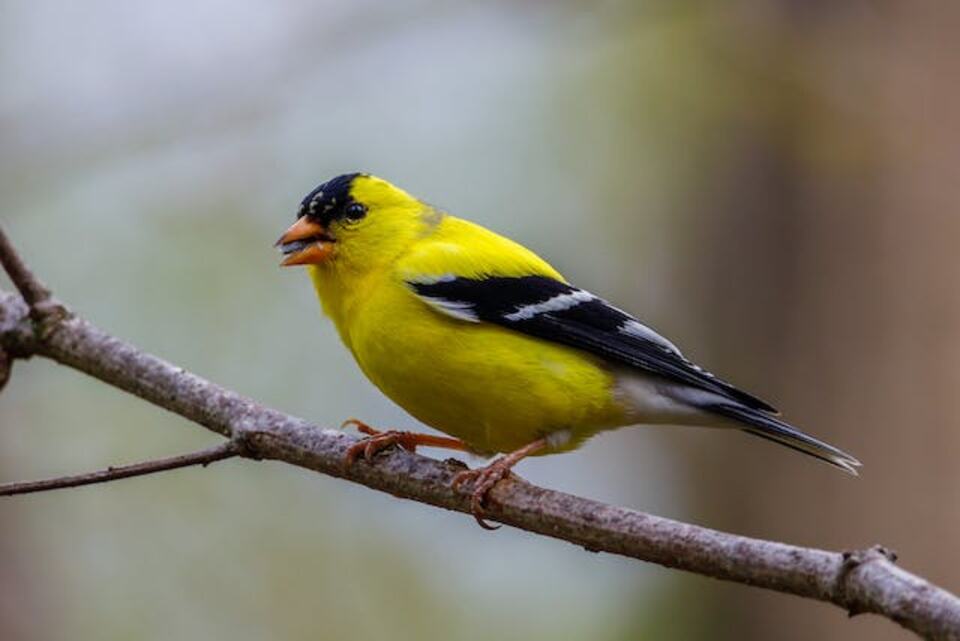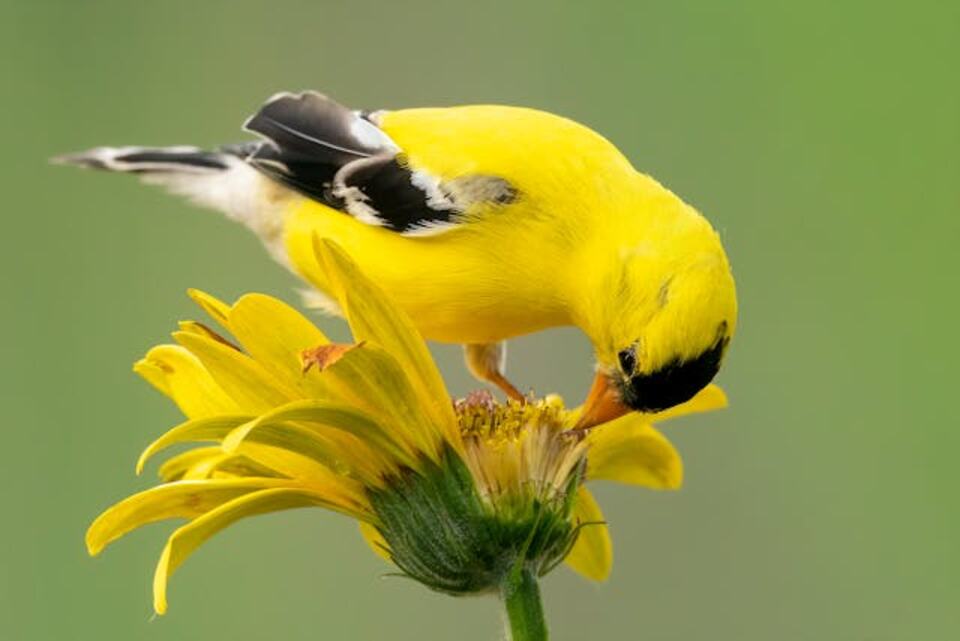The American Goldfinch, with its vibrant yellow plumage and cheerful song, is a beloved visitor to many backyards across North America. These small, charismatic birds can bring a burst of color and life to any outdoor space. If you’re looking to attract these golden beauties to your yard, you’ve come to the right place.
This comprehensive guide will walk you through everything you need to know about creating an inviting habitat for American Goldfinches, from understanding their behavior to selecting the right food and plants.
Table of Contents
- 1 Understanding the American Goldfinch
- 2 Physical Characteristics
- 3 Habitat and Range
- 4 Behavior and Diet
- 5 Creating an Inviting Habitat
- 6 Seasonal Considerations
- 7 Common Challenges and Solutions
- 8 Observing and Enjoying Your Goldfinch Visitors
- 9 Photography Tips
- 10 Conservation Considerations
- 11 Conclusion
- 12 Author
Understanding the American Goldfinch
Before diving into the specifics of attracting American Goldfinches, it’s essential to understand these charming birds. The American Goldfinch (Spinus tristis) is a small finch species native to North America. They are known for their distinctive bright yellow feathers in summer, which fade to a more subdued olive-brown during winter months.
Physical Characteristics
American Goldfinches are small songbirds, measuring about 4.3-5.1 inches (11-13 cm) in length with a wingspan of 7.5-8.7 inches (19-22 cm). They have a conical beak perfectly adapted for cracking open seeds, their primary food source. During the breeding season, male goldfinches sport a brilliant yellow body with black wings and a black cap on their head. Females and winter birds are more subdued in color, with olive-brown feathers and dull yellow underparts.
Habitat and Range
These birds are found across North America, from southern Canada to central Mexico. They prefer open areas with scattered trees and shrubs, including fields, meadows, orchards, and gardens. This preference for open habitats makes them excellent candidates for backyard bird-watching.
Behavior and Diet
American Goldfinches are social birds often seen in flocks, especially outside of the breeding season. They have a distinctive undulating flight pattern and are known for their acrobatic feeding habits, often hanging upside down on plant stems to reach seeds.
Their diet consists primarily of seeds, with a particular fondness for thistle (nyjer) seeds. They also consume sunflower seeds, aster, chickweed, and various other plant seeds. During the breeding season, they may supplement their diet with some insects, particularly to feed their young.
Creating an Inviting Habitat
Now that we understand the basics of American Goldfinch behavior and preferences, let’s explore how to create an environment that will attract these birds to your yard.
1. Provide the Right Food
The key to attracting American Goldfinches is offering their favorite foods. Here are some top choices:
- Nyjer (Thistle) Seeds: This is the goldfinch’s favorite food. Offer nyjer seeds in special thistle feeders or sock feeders.
- Sunflower Seeds: Black oil sunflower seeds are another favorite. Offer them in tube feeders or platform feeders.
- Mixed Seed Blends: Look for mixes that contain nyjer and sunflower seeds.
- Natural Food Sources: Plant native seed-bearing flowers and allow them to go to seed.
2. Use the Right Feeders
The type of feeder you use can make a big difference in attracting goldfinches. Here are some suitable options:
- Tube Feeders: These vertical feeders with multiple ports work well for nyjer and sunflower seeds.
- Mesh or Sock Feeders: These allow goldfinches to cling and feed in their natural position.
- Platform Feeders: These open trays can accommodate multiple birds at once.
- Nyjer Feeders: These specialized feeders have tiny holes that dispense nyjer seeds without waste.
3. Plant Native Seed-Bearing Plants
Incorporating native plants into your landscape not only provides natural food sources but also creates a more authentic habitat for goldfinches. Some excellent choices include:
- Sunflowers: Plant a variety of sunflowers for a continuous food source.
- Coneflowers (Echinacea): These provide seeds in late summer and fall.
- Zinnias: Allow these colorful flowers to go to seed for goldfinches.
- Thistle: If local regulations allow, consider planting native thistles.
- Asters: These late-blooming flowers provide seeds in autumn.
- Cosmos: Another great option for late-season seeds.
4. Provide a Water Source
Like all birds, goldfinches need fresh water for drinking and bathing. Consider adding a birdbath or shallow water feature to your yard. Keep these points in mind:
- Place the water source in an open area where birds can easily spot predators.
- Keep the water fresh and clean, changing it regularly.
- Consider adding a dripper or fountain to create moving water, which attracts birds more readily.
5. Offer Nesting Materials
While American Goldfinches don’t typically use birdhouses, you can still support their nesting habits by providing suitable materials. They build their nests using:
- Plant fibers
- Grass stems
- Moss
- Spider silk
You can offer these materials by leaving small piles in your yard or by filling a suet cage with suitable nesting materials.
6. Create a Safe Environment
To ensure goldfinches feel secure in your yard:
- Place feeders near natural cover like trees or shrubs, but not so close that predators can easily ambush feeding birds.
- Keep cats indoors or supervise them when outside.
- Use window decals or external screens to prevent window collisions.
Seasonal Considerations
American Goldfinches have different needs throughout the year, and understanding these can help you attract them year-round.
Spring
In spring, goldfinches begin to molt into their breeding plumage. They’re looking for abundant food sources to fuel this energy-intensive process. This is a great time to ensure your feeders are full and to start planting annuals that will provide seeds later in the season.
Summer
Summer is breeding season for goldfinches. They nest later than many other birds, typically in July and August. During this time, they’re looking for nesting materials and abundant food sources. Continue to provide seeds and allow some of your garden plants to go to seed.
Fall
In fall, goldfinches begin to form larger flocks and may become more visible in your yard. They’re preparing for winter by building up fat reserves. This is when your late-blooming flowers like coneflowers and asters become particularly valuable.
Winter
Winter can be a challenging time for goldfinches. They rely heavily on bird feeders during this season. Keep your feeders full and consider offering a variety of seeds to provide a well-rounded diet.
Common Challenges and Solutions
Even with the best preparations, you may encounter some challenges in attracting and maintaining goldfinch visitors. Here are some common issues and how to address them:
Problem: Goldfinches visit once but don’t return
Solution: Ensure a consistent food supply. Goldfinches are creatures of habit and will return to reliable food sources. Also, check that your yard feels safe to them – are there nearby perches or cover?
Problem: Seeds in the feeder are going bad
Solution: In humid weather, seeds can spoil quickly. Only fill your feeders with as much seed as can be consumed in a few days. Clean and refill feeders regularly.
Problem: Other birds are monopolizing the feeders
Solution: Use specialized nyjer feeders that are difficult for larger birds to use. You can also set up multiple feeding stations to reduce competition.
Problem: Squirrels are raiding the feeders
Solution: Use squirrel-proof feeders or baffles to deter these clever creatures. Positioning feeders away from structures that squirrels can use to jump from can also help.
Observing and Enjoying Your Goldfinch Visitors
Once you’ve successfully attracted American Goldfinches to your yard, take time to observe and enjoy these delightful birds. Here are some behaviors to watch for:
- Acrobatic Feeding: Goldfinches are known for their ability to feed upside-down. Watch as they cling to feeders and plant stems in various positions.
- Courtship Displays: In spring and summer, watch for males performing undulating flight displays to attract mates.
- Molting: Observe the gradual color change of male goldfinches as they transition between their dull winter plumage and bright breeding colors.
- Flock Behavior: In fall and winter, enjoy the charming sight of goldfinch flocks moving together through your yard.
Consider keeping a journal to record your observations. Note when goldfinches first appear in your yard, their numbers, behaviors, and any interesting interactions with other birds or your garden plants.
Photography Tips
If you’re interested in photographing your goldfinch visitors, here are a few tips:
- Use a zoom lens to capture close-up shots without disturbing the birds.
- Set up near a feeder or popular perch and wait patiently.
- Early morning and late afternoon often provide the best light for bird photography.
- Pay attention to the background – a clean, out-of-focus background can make your subject pop.
- Capture birds in various poses – feeding, in flight, interacting with other birds.
Conservation Considerations
While American Goldfinches are not currently considered a species of conservation concern, all wild bird populations face challenges from habitat loss, climate change, and other human activities. By creating a wildlife-friendly yard, you’re not only enjoying these beautiful birds but also contributing to their conservation.
Consider these additional steps to support goldfinch conservation:
- Avoid using pesticides in your yard, as these can harm birds directly and reduce their insect food sources.
- Participate in citizen science projects like the Great Backyard Bird Count or Project FeederWatch to help scientists track bird populations.
- Support organizations working to protect bird habitats and promote bird-friendly policies.
- Educate others about the joys of bird-watching and the importance of creating wildlife-friendly spaces.
Conclusion
Attracting American Goldfinches to your yard is a rewarding endeavor that can bring endless joy and a deeper connection to nature. By providing the right food, water, and habitat, you can create a goldfinch-friendly environment that supports these charming birds throughout the year.
Remember, patience is key. It may take time for goldfinches to discover your yard, but once they do, they’re likely to become regular visitors. Each season brings new opportunities to observe and appreciate these golden beauties, from their striking summer plumage to their cheerful winter flocks.
As you embark on your journey to attract American Goldfinches, you’re not just creating a beautiful and lively outdoor space – you’re also playing a crucial role in supporting local biodiversity and conservation efforts. So fill those feeders, plant those native flowers, and get ready to welcome a flash of gold to your backyard oasis. Happy bird-watching!





